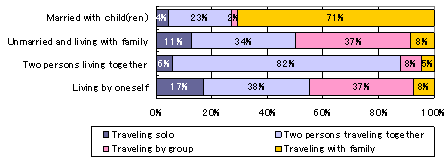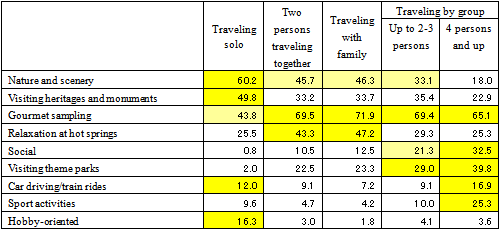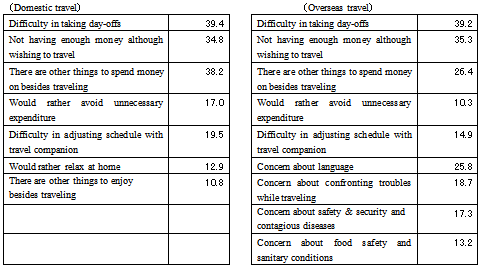JTM’s Survey Result: Consumption and Travel Trends for Japanese Youth in Their Twenties (Part 3)
One's travel style and travel destination largely depend on whom to travel with. For Japanese youth in their twenties, travel companion is an important factor in deciding on their overseas trip. What type of travel do they prefer? What are the obstacles to traveling? How do travel companions affect their travel style? The recent JTM survey on consumption and travel trends for Japanese youth in their twenties reveals.

Mayuko Kono Executive officer / Lead Consultant
The previous report examined travel experiences of Japanese youth in their twenties according to their household income level. The report continues to explore whom they would like to travel with and what type of travel they prefer.
For Japanese youth in their twenties, travel companion seems to matter almost as much as travel expenses and length of holidays. To the survey question, “With whom do you like to travel together most?” nearly half (45%) of respondents choose “Spouse/boy (girl) friend”, followed by “a few friends” (21%), “Family” (18%) and “By oneself” (14%). Looking at respondents by family construction, for majority of married respondents with children ‘family members including children’ are their most preferred travel companions. The rest of the respondents like to travel with either ‘spouse or boy (girl) friend’, ‘close friends or housemate’. Unmarried female respondents are likely to prefer traveling by group of friends, while unmarried male respondents prefer traveling solo.
Then, what type of travel would Japanese youth enjoy with their most preferred travel companions? The survey result shows that travel purposes such as ‘to enjoy nature and scenery’ and ‘sampling local cuisine’ ranked high in general. The young respondents prefer relaxing at hot springs when two persons travel together and traveling with family. It indicates that being together itself can be one of the purposes of travel when young people traveling with someone close to them. Meanwhile, when it comes to group travel, respondents prefer to share the same purpose and pleasure, such as to visit theme parks and enjoy sport activities. Hobby-oriented purpose is favored for solo travelers, as there is no companion to care about. The survey result illustrates Japanese youth in their twenties adapt their style of traveling to suit their travel companion.
Now, what are the obstacles for Japanese youth in their twenties to make domestic and overseas leisure travel? Survey respondents point out common difficulties both for domestic and overseas travel. The top three are; 1. Financial difficulty, 2. Difficulty in taking leaves from work while traveling,
3. Difficulty in adjusting travel schedule with travel companion. Another concern is difficulty in scheduling or re-scheduling travel itinerary with travel companions.
The second top reason for not going on domestic travel and the third reason for overseas travel is “There are other things/occasions to spend money on rather than traveling”. The result does reflect certain reality of Japanese young consumers’ everyday life being economically challenged. As explored in the “Part 1” of the report, many young consumers in Japan today must rely on sizable amounts of money such as bonus, to manage their daily expenditure due to limited amount of their monthly income.
Other obstacles to make overseas travel besides factors shown above include concerns about language, terror attacks, contagious disease such as SARS, safety & security, sanitary conditions and food safety.
The JTM survey has disclosed characteristics of Japanese youth in their twenties that rationally select what to spend money on and where to travel, attaching importance to human relations. By the time Japanese consumers of this age group become elderly with increased amount of household income, possibly with less concern such as about safety & security and sanitary condition, their style of travel might transform favorably both for consumers themselves and travel industry.
Chart 1: With whom do you like to travel together most? (By family construction), male

Chart 2: With whom do you like to travel together most? (By family construction), female

Table 1: Favorable travel activities by travel companion (%)

Table 2: Reasons for hesitating to travel:(Multiple answer/total of top three priorities/%)

